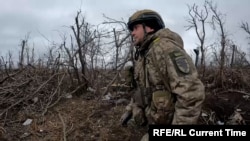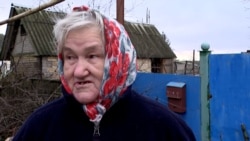Near BAKHMUT, Ukraine -- In the final days of 2023, snow and fog has given way to sunshine along Ukraine's eastern front, but the improved weather brings its own dangers for Ukrainian soldiers operating close to Bakhmut.
For Ukrainian tank crews, the sunny days mean that they need to camouflage themselves and their equipment even more carefully than usual as they continue to repel attacks launched by Russian forces from the nearby city.
A year ago, Bakhmut and other nearby areas were the site of some of the most intense fighting of the war since Russia's February 2022 full-scale invasion. Artillery barrages have left the city decimated and under Russian control since the spring, with Ukrainian President Volodymyr Zelenskiy vowing to retake Bakhmut in September.
Now, Oleksandr, a mechanic turned tank operator who asked to be identified by only his first name, spends most of his time holding the Ukrainian line on the outskirts of Bakhmut, where assaults and exchanges of artillery have become a fixture of daily life. With the sun shining on a late December day, his crew has been tasked with being ready to shoot from closed positions, only risking open-field fighting -- which leaves them exposed to attack drones -- on rare occasions.
Conscripted a year ago after initially trying to enlist in the immediate aftermath of the Russian invasion, Oleksandr says that his will to fight has only grown, especially amid the high casualty figures that prolonged bloody battles have brought.
"My arms and legs are intact. I understand that we don't have enough people, we really don't have enough people," Oleksandr told Current Time, a Russian-language network run by RFE/RL in cooperation with VOA.
"They keep coming and going by the thousands," he added, in reference to Ukrainian soldiers killed and wounded fighting in eastern Ukraine. "Every arm and every leg in Ukraine is worth its weight in gold."
The strategic stasis outside of Bakhmut has come to reflect the war's reality as 2024 approaches. Kyiv's once highly anticipated counteroffensive has largely stalled and Western funding for the war continues to falter amid rising living costs and declining approval ratings across the West.
The Biden administration's proposed $60 billion aid package to Ukraine to cover the country's anticipated needs through 2024 has been held up for months amid political deadlock in Washington. As a result, the administration has been forced since August to curtail the size of the bimonthly military aid packages to Ukraine as authorized funding runs dangerously low. The State Department announced on December 28 its latest weapons package for $250 million, bringing the monthly total to $450 million. From March 2022 through July 2023, U.S. military aid averaged more than $1 billion a month.
Despite stalling progress on the battlefield, Ukraine has pressed ahead in recent days with an attack on Russia's Black Sea Fleet near the Crimean port city of Feodosia and December 29 air attacks on southern Russia's Belgorod and Bryansk regions.
Moscow has also stepped up its own attacks, with Russia firing more than 150 missiles and drones at Ukraine on December 29 in one of the largest bombardments of the war. The aerial attack has left 39 people dead, at least 160 wounded, and an unknown number buried under the rubble in the assault, according to Ukraine's Interior Ministry.
The scale of the bombardment appeared to confirm recent warnings from Western officials and analysts that Russia had been limiting its cruise-missile strikes for months in an apparent effort to build up stockpiles for massive barrages during the winter, hoping to break the morale of Ukrainians.
'That's How We Live'
Less than 20 kilometers west of Bakhmut, the town of Chasiv Yar's remaining 800 residents have adapted to the grueling reality of wartime life.
Constant barrages from the Russian military have become a fixture of life over the last year but have left much of the town in rubble or its buildings damaged.
Yuriy, a longtime resident of Chasiv Yar, says that it's so cold in his house that the tea in his cup froze. The town lacks any proper heating and most residents subsist on what wood they can gather to burn, but with temperatures dipping and supplies running low, that's proving more difficult by the day.
Yuriy spoke to Current Time while trying to contact his neighbor who had left town that the windows and doors on her apartment have all been knocked out from shelling. He says that he currently spends his time checking in on her apartment, looking for supplies, and warming up at one of the small heating tents that local officials have set up for the remaining residents.
"That's how we live. It's minus 3 [degrees Celsius] in the room," Yuriy said. "So we came, warmed up, and then we go there again."
Yuriy says that today he is lucky, as Chasiv Yar's mayor and his team brought him a cylinder with gas to help with heating and cooking. He explains that with fuel in such short supply, he uses it strategically to heat one small room and then conserve the rest for cooking, which can be used to boil a kettle or warm a small stovetop.
Natalya, another Chasiv Yar resident, says that she worries about what's next for her town and Ukraine.
"I'm worried. The United States is holding back help. There are fewer munitions," she said. "The manpower [and resources] on the other side is greater than in Ukraine. So, I'm worried."
2024's New Phase
Uncertainty over the level of Western military assistance for Ukraine will follow Kyiv into 2024.
The recent funding announced by Washington provides a stopgap, but it gives no long-term clarity on helping Ukraine resolve its ammunition shortages and military planning for the coming year.
White House officials have suggested that this weapons package, known as a "drawdown" from Pentagon inventories, was the last one they could make with existing funds. Any new assistance will require the approval of Congress and the legislation for a new package put forward by the White House is currently stalled as negotiators try to find a compromise on border security and immigration policy, key demands from Republicans in agreeing to any future deal.
Political battles have also stalled aid from Kyiv's other Western backers. In Brussels, Hungarian Prime Minister Viktor Orban is blocking a proposed plan of 50 billion euros ($55 billion) in new assistance for Ukraine from the European Union.
According to the Financial Times newspaper, the bloc is preparing a back-up plan worth up to 20 billion euros ($22 billion) for Ukraine, using a debt structure that sidesteps Orban should he refuse to drop his veto by a planned EU summit on February 1.
Securing future military assistance is vital for Ukraine if it is to make progress in its goal of pushing back Russian forces. Speaking at a press conference in late December, Zelenskiy said that Ukraine's military leadership submitted a plan to him to mobilize up to 500,000 more troops for the fight against Russia that is estimated to cost some $13 billion. "I would like to know where the money will come from," the Ukrainian president remarked.
Elsewhere, Western officials have been pushing for more military assistance for Ukraine and warning of the consequences should support for Kyiv dry up.
"Wars develop in phases," NATO Secretary-General Jens Stoltenberg said in an interview on December 3 with the German broadcaster ARD. "We have to support Ukraine in both good and bad times."
"We should also be prepared for bad news," Stoltenberg added, without offering specifics.














